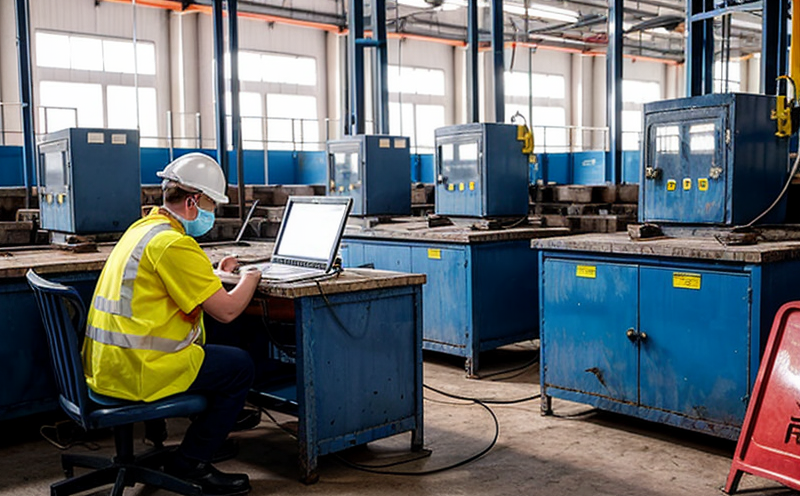ISO 9241 Ergonomic Testing of Visual Display Units in Factories
The ISO 9241 series of standards provides guidelines on ergonomics for the design and use of visual display units (VDUs) and other interactive computer systems. In industrial manufacturing environments, where workers spend significant time interacting with VDUs, ensuring their ergonomic suitability is crucial to prevent strain-related injuries and enhance productivity.
Our laboratory offers comprehensive ISO 9241 testing services specifically tailored for factories. This includes evaluating the layout of workstations, lighting conditions, seating arrangements, and the overall interaction between workers and their VDUs. By adhering strictly to international standards like ISO 9241-100:2015, we ensure that our test protocols are both rigorous and relevant.
The testing process begins with a detailed assessment of the current working conditions in the factory setting. This involves measuring ambient light levels, evaluating the height and position of VDUs relative to user height, assessing the visibility of information presented on screens, and checking for glare or reflections that might impair visual comfort.
Our team uses advanced instrumentation such as photometers to measure light intensity and spectrophotometers to analyze color rendering indices. We also employ anthropometric data to ensure that the design of workstations supports a wide range of users. The goal is not only to comply with standards but also to create an environment where workers can perform their tasks efficiently while minimizing risk.
One critical aspect of our testing involves simulating typical factory environments, including noise levels and temperature variations. This ensures that the ergonomic design recommendations are robust enough to withstand real-world conditions. We often find that minor adjustments in lighting or workstation configuration can significantly impact worker comfort and performance.
The results of these tests provide actionable insights for factories looking to improve their occupational health and safety practices. By identifying areas where improvements are needed, we help our clients implement changes that not only comply with international standards but also enhance the overall working environment. This can lead to reduced absenteeism due to ergonomic-related injuries and improved employee satisfaction.
- Measure ambient light levels and ensure compliance with ISO 9241-100:2015
- Evaluate VDU height relative to user height using anthropometric data
- Assess screen visibility under various lighting conditions
- Identify glare sources and recommend solutions to mitigate their effects
Benefits
The implementation of ISO 9241 ergonomic testing in factories offers numerous benefits. Firstly, it helps manufacturers achieve compliance with international standards, which is essential for maintaining a positive reputation and ensuring legal adherence. Secondly, by identifying potential risks early on, factories can proactively address issues before they lead to accidents or injuries.
Moreover, this testing process contributes to the creation of safer work environments, reducing the likelihood of musculoskeletal disorders (MSDs) among employees who spend considerable time in front of VDUs. Improved ergonomics also lead to increased productivity and reduced operational costs associated with absenteeism and medical leave.
From a long-term perspective, investing in ISO 9241 compliance can contribute positively to the company’s brand image and customer trust. It demonstrates a commitment to employee well-being and sustainable business practices. Lastly, it provides valuable data that can be used for ongoing improvements in workplace design and user experience.
Why Choose This Test
- Comprehensive evaluation of VDU setups according to ISO standards
- Use of cutting-edge instrumentation for precise measurements
- Simulation of real-world factory environments for accurate testing
- Detailed reporting tailored to specific factory needs and challenges
We understand the unique demands placed on industrial workers in manufacturing environments. Our expertise lies in providing customized solutions that address these specific requirements while ensuring compliance with international standards.
Competitive Advantage and Market Impact
By incorporating ISO 9241 ergonomic testing into their quality management systems, factories gain a competitive edge in several ways. For one, they demonstrate their commitment to occupational health and safety, which can attract top talent and enhance employee loyalty.
The data generated from these tests also provides valuable insights that can be leveraged for innovation within the factory. This not only improves operational efficiency but also sets a benchmark for industry best practices. Additionally, compliance with international standards can open doors to new markets where stringent safety regulations are in place.
In an increasingly globalized market, demonstrating a proactive approach to ergonomics is becoming essential. Companies that prioritize worker well-being are more likely to be seen as responsible and forward-thinking partners by both current and potential clients.





